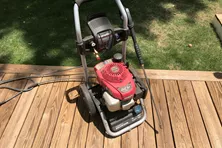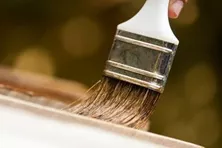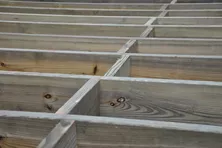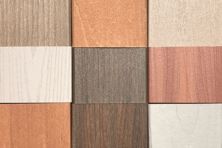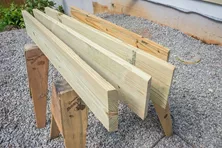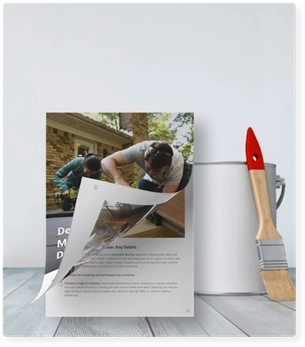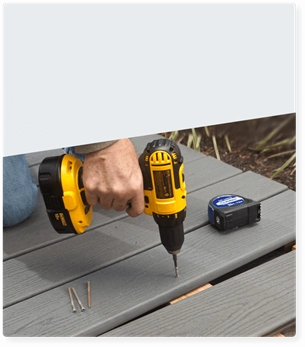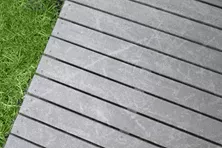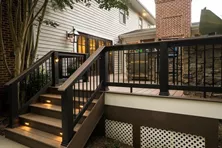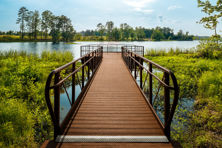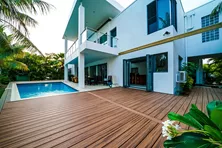How To Fix Loose Deck Railing and Prevent Wobbly Banisters for Years
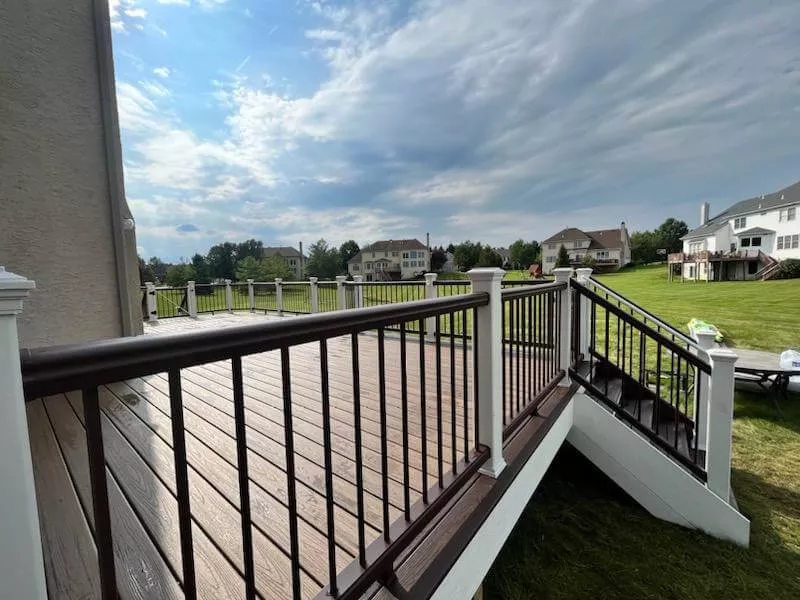
When enjoying your outdoor living space, the last thing you want to worry about is a wobbly or loose deck railing. Before you head out to the deck with friends and family, take some time to learn how to fix loose outdoor railings.
In this article, we’ll explore several reasons deck railings fail and how you can repair deck railings according to their cause of damage. The deck railing is extremely important to keep secure to avoid any injuries or violations of the code.
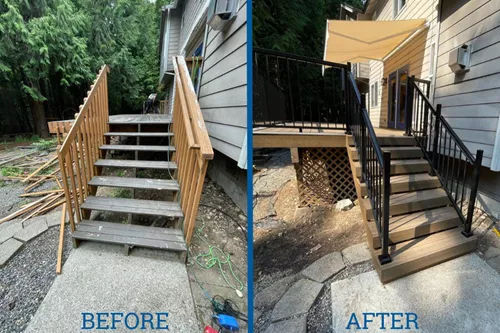
Reasons Why Your Deck Railing Might Be Wobbly
Before attempting to fix a loose deck or porch railing, inspect it closely. Taking the time to properly diagnose the underlying cause is key to choosing the right porch railing repair method. A thorough inspection before breaking out the tools can prevent wasted time with ineffective solutions.
Weather Damage
Weather is a common cause of loose deck railings. Prolonged exposure to sunlight can fade, warp, and dry out the wood. Over time, this can weaken its structure and loosen connections. Humidity and moisture can cause wood to rot and hardware to rust.
Strong winds can also be an issue. As winds create constant movement in railings, the connections are stressed and the attachments weaken. Hailstorms can dent and damage railings while impacts can weaken connections.
Finally, you may find yourself needing to fix deck railings more often if you live in a coastal area. Prolonged salt exposure can accelerate corrosion on metal compounds, though regular cleanings can mitigate damage.
Warped or Damaged Wood
Wood railings expand and shrink with the seasons as temperatures change. Continuous freeze and thaw cycles can cause the hardware holding your railings together to loosen over time. Periodically tightening carriage bolts and screws can eliminate wobbling in your railing, but it may come back again.
Another potential cause of a wobbly wooden railing is that a weakened spot has compromised the stability of the railing attachments. In this scenario, the wood may need to be replaced.
If you find yourself constantly maintaining a wood railing, a composite one may be better long-term. Low-maintenance composite railings resist warping from weather, and composite porch railing repair is less frequent.
Loose, Old or Damaged Hardware
If your deck railing is loose or wobbly, it is probably the result of a weak rail post connection to the deck frame. Posts should be connected to the deck framing with approved lag screws or bolts at a minimum. Screws or nails are not generally acceptable.
But even appropriate deck hardware is vulnerable to moisture, UV rays, and temperature changes. Over time, it can rust and rot. As a deck owner, you should regularly check your deck’s hardware for signs of rust, corrosion, or deterioration. Applying protective coatings like sealants can help shield hardware against the elements.
But in some cases, extensively rusted, rotted, or even broken hardware may need to be replaced. If you suspect damaged hardware is behind your loose railing, remove it carefully to avoid damaging the surrounding wood. Then replace it with resilient hardware that matches the original size and type. Opt for stainless steel, galvanized, or coated hardware to resist rust and corrosion.
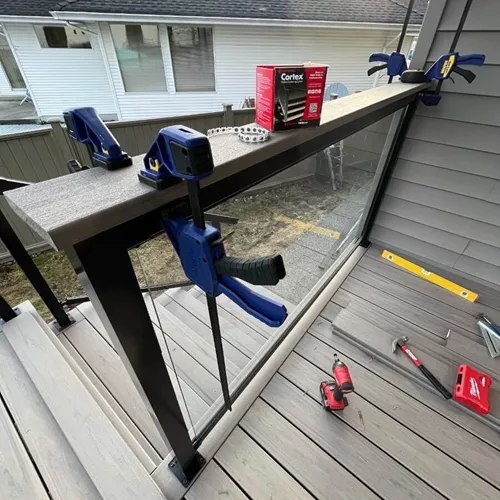
How to Fix Loose Deck Railing and Wobbly Posts
Regularly checking your deck’s rails and posts can keep your deck safe for family fun. It’s best to address any findings sooner than later before they become a hazard. Follow this process to learn how to secure wobbly deck railings and prevent future issues.
1. Inspect Every Component
Start by inspecting your deck to identify what is causing the loose railing and posts. Look for things like worn or rusted hardware, cracks, and wood rot. Understanding the issue is the first step when figuring out how to fix a loose outdoor railing.
2. Check and Tighten Hardware
Examine where rails connect to posts and where posts mount to the deck. See if screws, bolts, or nails have come loose. Use a ratchet or drill for your porch railing repair and tighten any loose hardware. Don't over-tighten. You just want a snug fit.
3. Reinforce Connections
If simply tightening doesn't fix the wobble, the connections themselves may need reinforcing. Consider using metal brackets, wood blocking, or specialty reinforcers made to repair deck railings. Strengthening joints makes the whole structure more secure.
4. Weatherproof Components
Prevent future wobble by sealing any exposed wood or metal. Apply weatherproof paint or coating to protect from moisture damage over time. Maintaining your deck proactively avoids issues down the road.
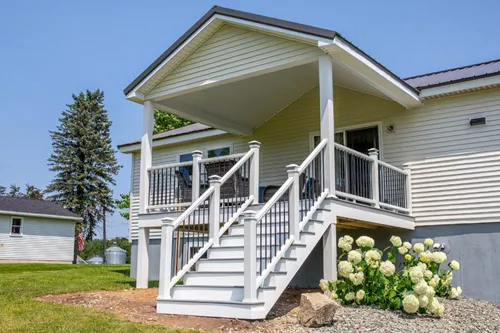
Loose Deck Repair Tips for Different Deck Materials
When discussing repair steps for a loose deck railing, it’s important to note that different decking materials can benefit from targeted repair techniques. Knowing how to fix deck railings based on their material can help you quickly address the issue.
Composite
With composite, you’re less likely to have to repair deck railings. Composite decking is inherently resistant to many issues that affect traditional wood decks. But if something does come loose, here’s what you can do.
- Start by identifying the specific area or component that’s become loose.
- Inspect every board, making sure that they’re all level and properly aligned. Adjust them as necessary.
- Next, check and tighten any screws or fasteners in question. Keep in mind that composite materials don’t expand and contract as much with temperature changes, so the likelihood of screws or fasteners becoming loose is minimized.
- Finally, keep up with maintenance. Composite decks typically only require debris removal as needed, though routine inspections can help spot issues early on so you can address them before they become a serious problem.
Wood
Wood decks can be beautifully designed and flawlessly built but still fall victim to weather, moisture, and wear and tear. Here’s how to approach deck railing repairs on a wooden structure.
- Identify the root cause. Knowing how to repair deck railings made from wood starts by knowing what’s caused the damage. In most cases, moisture or temperature changes are to blame since they cause the wood to contract and expand.
- Carefully inspect and tighten screws, nails, or bolts as needed.
- When tightening alone isn’t enough, reinforce weak areas with additional fasteners.
- The key to avoiding wooden deck repairs is to keep up with maintenance, including frequent inspections, restaining and sealing as needed, and addressing issues as soon as possible.
Metal
Metal banisters can add a modern touch to a deck, but occasional maintenance is important. Knowing how to stabilize deck posts and banisters can help you keep your deck safe all year.
- Inspect metal banisters for any signs of wobbling or looseness. Vibrations over time can gradually weaken fasteners and connections.
- Next, tighten screws and bolts as needed.
- If the wobbling persists, add hardware to strengthen the connection between the metal banisters and the deck’s structure.
- Then, examine each banister for rust, corrosion, or wear signs. Regular cleaning and rust prevention can enhance the longevity of your metal components.
When it comes to knowing how to reinforce deck railing posts, having more than one approach is helpful. Additionally, if your rail posts are mounted to the interior of the frame, you can add strength to the rail by installing blocking around the post to trap the post in a pocket. If your railing posts are connected to the outside of the frame, you can try to tighten the bolts and install blocking to the rim joist to stiffen the rail.
If your rail posts are mounted to the interior of the frame, you can add strength to the rail by installing blocking around the post to trap the post in a pocket. If your railing posts are connected to the outside of the frame, you can try to tighten the bolts and install blocking to the rim joist to stiffen the rail.
There is hardware available to help strengthen the rail.
Plastic and Vinyl
Plastic and vinyl decking is less prone to certain issues but can still experience minor loosening. Here’s how to tighten vinyl railing for a safe outdoor living space.
- Inspect your plastic or vinyl railings, posts, and decking for signs of instability that may be caused by temperature shifts.
- Tighten any fasteners with the appropriate tools, being careful not to over-tighten based on expected weather changes.
- Begin a routine cleaning regimen for your plastic or vinyl railings to prevent dirt and debris accumulation, which can contribute to wobbling over time.
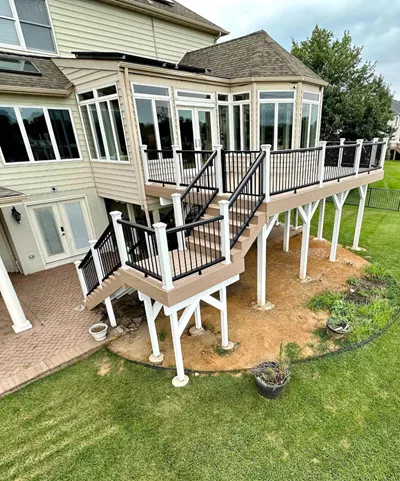
Learn More About Sturdy Composite Deck Railing
Now that your railings are sturdy, strong, and safe, explore these additional articles to learn more about deck railing systems, find inspiration for your next design, and estimate repair costs if needed.
Pressure Washer Buying Guide
When it comes to cleaning your deck, it's important to choose the right pressure washer. Use this pressure washer buying guide from Decks.com to help with your decision!
Can You Paint or Stain Composite Decking?
Most composites don’t require painting or staining. However, if you are considering staining or painting your deck, you can learn how to do so and what you’ll need at Decks.com.
How to Avoid, Prevent & Repair Deck Joist Rot
Rotted deck joists can cause homeowners headaches. Learn more about how to avoid, prevent and repair deck joist rot at Decks.com.
Capped Composite Decking
What is capped composite decking? It's a great option if you like the look of wood but not the maintenance. Learn about capped composite at Decks.com.
Harmony Select
Harmony Select Decking System is manufactured by Royal Mouldings Woodbridge in Ontario Canada
How to Dry & Treat Wet Wood
Wet wood shrinks as it dries out and becomes less stable, which can cause it to check and warp. Learn how to dry out and treat wet wood at Decks.com.
More Helpful Resources
Explore Articles by Topic

Footings
Information related to installing frost footings for decks

Framing
Learn structural framing methods

Decking
Learn about wood and composite decking materials

Stairs
An in-depth look at the complex issue of how to build stairs

Railings
How to install guardrails and handrails to meet IRC code

Features
An overview on water drainage, benches, planters and lights

Design
The basics of deck design

Planning
Learn about permits and working with contractors

Porches & Patios
Build a covered deck to enjoy all seasons

Ledger
Proper attachment techniques

Care
Maintain your deck to maintain your investment

Materials
An overview on water drainage, benches, planters and lights
How to Remove Scuffs and Scratches from Composite Decking
Removing scuffs and scratches can help make your composite deck look like new. Learn how to fix and prevent your composite deck from future scratches.
Best Deck Cleaner Options
Discover the best deck cleaning and brightening solutions for composite decks, wood decks, and more. Learn how to remove dirt, mildew, and algae with Decks.com.
Deck Inspection: Checklist for Framing, Footings and More
Concerned that your deck no longer meets safety regulations? Want to know how to spot signs of trouble for your deck? Review our checklist for inspecting your deck at Decks.com.
Eco Friendly Composite & Wood Decking Options
Looking for the most environmentally friendly way to add a gorgeous deck to your home? Learn how composite decking is made from recycled materials at Decks.com.
Endeck
Endeck PVC decking is manufactured by Enduris Extrusions in Jacksonville, FL.
Pool Decking Options
When choosing a pool deck material, you should consider slip-resistance, heat absorption and more. Find the best material for your pool deck with Decks.com.
Explore Articles by Topic

Footings
Information related to installing frost footings for decks

Framing
Learn structural framing methods

Decking
Learn about wood and composite decking materials

Stairs
An in-depth look at the complex issue of how to build stairs

Railings
How to install guardrails and handrails to meet IRC code

Features
An overview on water drainage, benches, planters and lights

Design
The basics of deck design

Planning
Learn about permits and working with contractors

Porches & Patios
Build a covered deck to enjoy all seasons

Ledger
Proper attachment techniques

Care
Maintain your deck to maintain your investment

Materials
An overview on water drainage, benches, planters and lights





